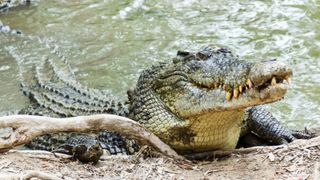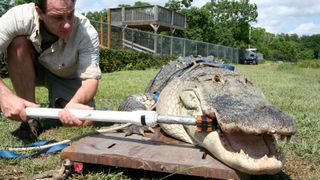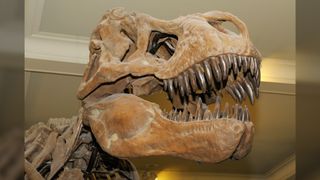
Which animals have the strongest bite?
Which living and extinct animals have the strongest bite forces on record?

Tyrannosaurus rex and megalodon are repeat science fiction stars for a reason: Their bites were ferocious. But which extinct and living creatures actually exert the strongest bite force?
Bite force, according to a study published in Frontiers, is the force that the muscles and bones of the upper and lower jaw generate when an animal bites. Animals with strong bite forces usually have no problem clamping down on struggling prey. Some predators are even able to break through prey with especially tough armor.
Of all the creatures alive today, the saltwater crocodile (Crocodylus porosus) has the strongest known bite force, at 16,460 newtons (newtons measure force magnitude), a 2012 study in the journal PLOS One found. For comparison, 1 newton equals about a quarter pound of force. Whatever ends up in the jaws of a saltwater crocodile is subjected to extreme force during its dying gasps.

There are two contenders that could challenge — and possibly beat — the croc, but their bite forces have not been measured in a live setting because these animals are aquatic predators. If confirmed, the strongest bite force could be that of the orca (Orcinus orca), estimated at 84,516 newtons by the Dutch Shark Society, distantly followed by the bite force of a great white shark (Carcharodon carcharias), at about 18,000 newtons, according to computer models used in a 2008 study published in the Journal of Zoology.
Among extinct animals, the chomp of T. rex may have been king, at a killer 35,000 newtons when it stomped the Earth from about 68 million to 66 million years ago. The huge shark Megalodon (Otodus megalodon) terrorized the seas from 15 million to 3.6 million years ago with a bite force of up to 182,200 newtons. However, there are still questions about whether the shark could beat out the dinosaur. They're difficult to pit against each other because shark and dinosaur jaws have different types and numbers of teeth, explained Jack Tseng, a biologist and assistant professor of integrative biology at the University of California, Berkeley.
Related: What is the toothiest animal on Earth?
Bite force can be measured directly or estimated indirectly. Living animals can bite down on a force gauge, which is how scientists measured the saltwater crocodile's extreme bite. For living animals that scientists have not been able to test this way, such as orcas and sharks, bite force is based on what is known about their body structure, shape and the type of prey they hunt.
Sign up for the Live Science daily newsletter now
Get the world’s most fascinating discoveries delivered straight to your inbox.
Extinct animals are trickier. Only the jaw bones remain in a skull, which is why researchers use computer simulations to recreate jaw muscles that have long since decomposed.
Making of a killer bite

What goes into a crushing bite? Multiple characteristics — including head and jaw strength — play roles. Teeth are also a weapon. T. rex's head alone had bone-crushing power, but it also had serrated knife-like teeth. However, there is one factor that dominates all others, if you ask Daniel Huber, a professor and chair of environmental studies at The University of Tampa in Florida.
"[Body] size is the single most important factor in determining bite force," Huber told Live Science in an email.
Huber has found that a predator’s size overwhelms everything else, including head width to the armor-like toughness of prey. The jaw adductor muscles, which are responsible for closing the jawbones, are crucial. "The sizes and positions of those adductors can be evolutionarily tweaked to maximize the amount of muscle force that can be transmitted into bite force," he told Live Science in an email.
The iconic T. rex presumably had powerful jaws, according to computer simulations of the dinosaur king. When factoring in the sharpness of its teeth, estimates of the dino's bite force skyrocket, Huber said. But part of that total force comes from not just bite force but also the extra bite pressure exerted by those sharp teeth.
"In general, the sharper the tooth tip, the higher the potential bite force given the same input muscle force, because any such force would be concentrated at the tip of a tooth," Tseng added.
Not all animals with a huge bite force are enormous and toothy. Some aren't even predators. The Galapagos large ground finch (Geospiza magnirostris) has the most intense bite force for its size, according to a 2019 study published in the journal Proceedings of the Royal Society B. This bird weighs only about 1 ounce (33 grams), but its beak can crack tough nuts and seeds with a force of 70 newtons, meaning it has the most powerful bite force for its body size, according to the study. That gives the finch 320 times the biting power of T. rex.
How do humans compare? The hardest bite our species can manage is around 1,000 newtons, so we're not even in the same league.

Elizabeth Rayne is a contributing writer for Live Science. Her work has appeared in SYFY WIRE, Forbidden Futures, Grunge and Den of Geek. She holds a bachelor of arts in English literature from Fairfield University in Connecticut and a master's degree in English writing from Fordham University, and most enjoys writing about space, along with biology, chemistry, physics, archaeology and paleontology.